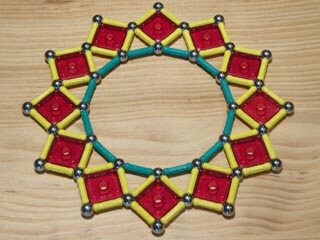Regular polygons
Only one rigid regular polygon can be built with Geomag without panels or auxiliary rods: the equilateral triangle.

Equilateral triangle
6 pieces: 3 balls, 3 rods (39.90 g)
|
Of course, that is why they invented panels. With them, you can easily make rigid squares and pentagons:

Square
9 pieces: 4 balls, 4 rods, 1 square (55.02 g)
|

Regular pentagon
11 pieces: 5 balls, 5 rods, 1 pentagon (69.50 g)
|
The regular hexagon has an easy solution, as it can be partitioned into six equilateral triangles. However, the result is rigid only while lying flat, as it can be folded along any of the main diagonals. Rhombic panels provide an alternative, saving three rods and making the main diagonals unfoldable:
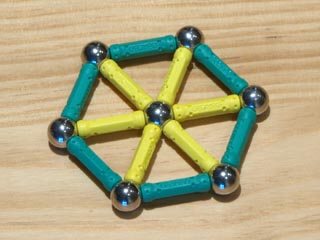
Regular hexagon with auxiliary rods
19 pieces: 7 balls, 12 rods (116.60 g)
|
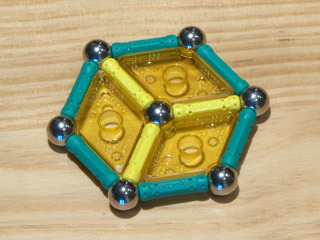
Regular hexagon with auxiliary rods and rhombuses
19 pieces: 7 balls, 9 rods, 3 rhombuses (106.82 g)
|
If a cuboctahedron is split by a plane parallel to two opposite triangular faces, the section is also a regular hexagon. Each half is a Johnson solid number 3, the triangular cupola (see
MathWorld article). If the hexagonal face is not stabilized with additional rods or panels, this body is not rigid (it could be, however, when belonging to certain bigger structures):
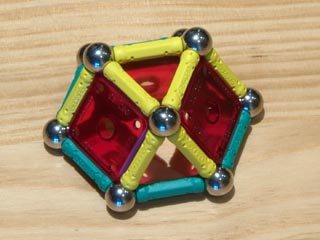
Regular hexagon from triangular cupola
27 pieces: 9 balls, 15 rods, 3 squares (153.36 g)
|
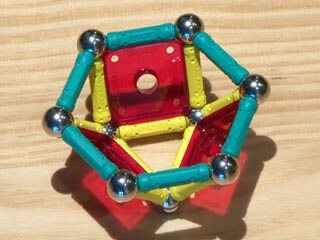
|
The base polygon of a square cupola (Johnson solid number 4), similarly, is a regular octagon which, again, is not rigid in itself, but becomes rigid when making up other structures, as is the case, for instance, in a truncated cube (in which there are six intermingled concave square cupolas, joined by a central cube) or a rhombicuboctahedron (in which there are six intermingled convex square cupolas):
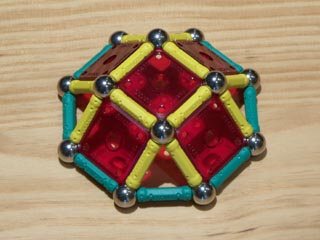
Regular octagon from square cupola
37 pieces: 12 balls, 20 rods, 5 squares (206.30 g)
|
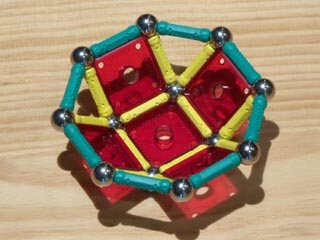
|
A pentagonal cupola (Johnson solid number 5) provides a regular decagon which becomes rigid, at least, in a rhombicosidodecahedron (twelve intermingled convex cupolas), in a truncated regular dodecahedron (twelve concave cupolas sharing edges), and in a rhombitruncated icosidodecahedron (twelve unconnected concave cupolas):
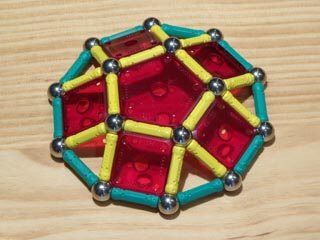
Regular decagon from pentagonal cupola
46 pieces: 15 balls, 25 rods, 1 pentagon, 5 squares (258.60 g)
|
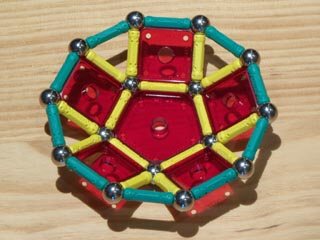
|
There is a regular decagon also in the base of a pentagonal rotunda (Johnson solid number 6, or half an icosidodecahedron). It cannot replace the pentagonal cupola when building a truncated regular dodecahedron, but it can when building a rhombitruncated icosidodecahedron, as explained in Concentric icosidodecahedra:
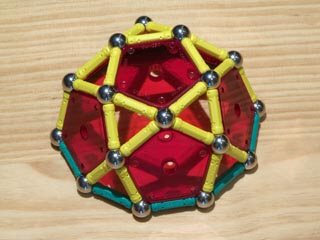
Regular decagon from pentagonal rotunda
61 pieces: 20 balls, 35 rods, 6 pentagons (354.50 g)
|
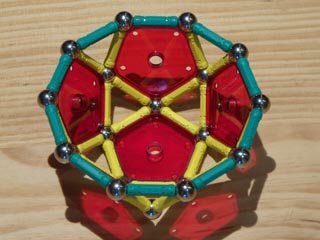
|
And a planar construction: Ten regular pentagons, joined by their edges, make up an internal regular decagon:
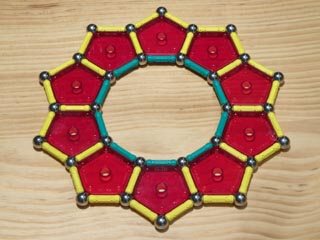
Regular decagon internal to pentagons
80 pieces: 30 balls, 40 rods, 10 pentagons (476.00 g)
|
Two planar constructions to build the regular dodecagon. Its vertices exactly match those of six squares built on the edges of a regular hexagon (left). On the other hand, twelve equilateral triangles laid over the edges of a regular dodecagon form right angles, so that their position can be stabilized with squares (right):
In the regular decagon made up of regular pentagons (above) a square can be interspersed between each pair of consecutive pentagons, so forming a regular 20-agon:
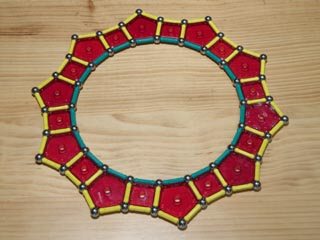
Regular 20-agon internal to squares and pentagons
140 pieces: 50 balls, 70 rods, 10 pentagons, 10 squares (807.20 g)
|
I don't know of any planar construction of a regular 24-agon, just this three-dimensional one, from a regular dodecagon. It can be built in either of the shown positions, but it is surely easier to build as in the right-hand picture:
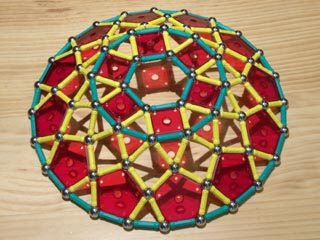
Regular 24-agon from regular dodecagon
210 pieces: 66 balls, 126 rods, 12 pentagons, 6 squares (1.21 kg)
|
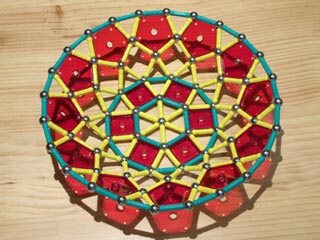
|
Finally, a planar construction for the regular 30-agon: Fifteen regular pentagons joined by a vertex, with interspersed equilateral triangles:
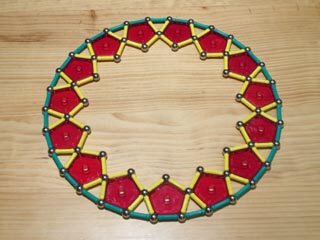
Regular 30-agon external to triangles and pentagons
165 pieces: 60 balls, 90 rods, 15 pentagons (984.00 g)
|
- The regular 20-agon built from squares and pentagons is the basis for this construction of the Geomag logo, a pair of small mosques, and a chapel.
- The construction of the 24-agon arose when building platforms for these Towers.
- The regular 30-agon is used as base building for this mosque.

